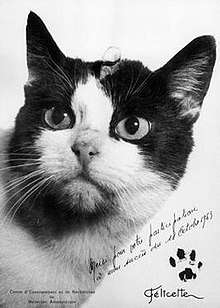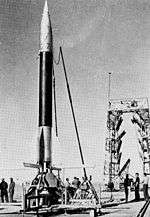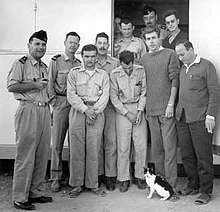Félicette
 Inscription: Thank you for your participation in my success of 18 October 1963[1] | |
| Species | Felis catus |
|---|---|
| Sex | Female |
| Known for | The first cat in space |
| Owner | French government |
| Appearance | Tuxedo cat |
Félicette (French pronunciation: [fe.liː.sɛt]) was the first cat to have been launched into space.[2] She was launched on 18 October 1963, by France, and is the only cat to have survived spaceflight; a second feline was launched on 24 October, but the mission resulted in a fatality.[3]
Félicette has been commemorated on postage stamps around the world,[4] and in 2017 a funding campaign for a memorial was launched.[5]
Prior non-human animals in space
On 3 November 1957 the Soviets sent Laika, a dog, into space on Sputnik 2. The dog was a stray found on the streets of Moscow. She died in space, but was the first animal to be launched into space and orbit the Earth. On 31 January 1961, as part of Project Mercury, the chimpanzee Ham became the first hominid launched into space; his mission was a suborbital flight. On 29 November 1961, Enos became the first chimp, and third hominid after cosmonauts Yuri Gagarin and Gherman Titov, to achieve Earth orbit. He orbited the Earth for 1 hour and 28 minutes. surviving the flight and reentry.
Mission

Félicette was a black-and-white stray cat, found on the streets of Paris by a pet dealer, and later was purchased by the French government.[6] The French had 14 cats in training (in equipment such as high-G centrifuges and compression chambers) in 1963.[7] The animals were trained by the Centre d'Enseignement et de Recherches de Médecine Aéronautique (CERMA).[6] During testing, all of the cats had permanent electrodes wired into their brain to assess neurological activity.[6]
On 18 October 1963 at 8:09 am, Félicette was launched into space from the Centre interarmées d'essais d'engins spéciaux site in Algeria on a Véronique AGI 47 sounding rocket (made in Vernon, Haute-Normandie).[8] Véronique came from the German World War II Aggregate rocket family and led to the French Diamant satellite launcher. The Veronique AGI was developed for the International Geophysical Year (French: Année géophysique internationale) in 1957 for biological research. Out of the fifteen AGI 47 rockets assembled, 7 would carry live animals.
The mission was a sub-orbital flight, and lasted 13 minutes, reaching a height of 157 kilometers, and included 5 minutes of weightlessness. Félicette was recovered safely after the capsule parachuted to Earth; she was euthanized three months later so that scientists could examine her brain.[9][7]
A second feline was launched into space on 24 October. Unlike Félicette, the second cat died as the capsule was not recovered.[3]
Legacy

According to an article in Space.com on 8 November 2017, the participation of Félicette in the space race:
...was certainly not voluntary, but it was a huge milestone for France, which had just established the world's third civilian space agency (after the U.S. and the Soviet Union). Félicette's mission helped bring France into the space race.[5]
The article also mentions that in the 1960s, scientists wanted to understand how the lack of gravity would affect animals, to understand what would happen to humans, and "these cats went through the same intensive training as human astronauts" Ultimately, Félicette was chosen for the mission over 13 other cats in training partially due to her calm disposition.[5]
In 1997, postage stamps commemorating Félicette and other animals in space were created in Chad.[10] Félicette's legacy was somewhat obscured as a number of commemorative stamps from different countries mistakenly identified her as a male cat named Félix.[5][11]
While some non-human animals who traveled in space were celebrated as heroes - the chimpanzee Ham was buried at the International Space Hall of Fame, and the Soviet dog Laika launched in 1957 has a bronze at the Star City cosmonaut training facility - there was no memorial for Félicette. To rectify this oversight, in 2017 a crowdfunding campaign was started by Matthew Serge Guy to erect a bronze statue of Félicette to commemorate her contribution to science.[5] Guy said:
I was touched by how, out of all the animal astronauts' stories, Félicette’s story seems to be the one that’s become twisted the most over the years, with some people even thinking she was a male cat named Felix... By proposing a statue, I guess I was hoping to set her story straight in a big way.[5]
Guy also said that if the crowdfunding is successful, the statue is planned to be designed by sculptor Gill Parker, and installed in Félicette's hometown, Paris. A preliminary sketch of the monument depicts a cat on top of a rocket, and will include a plaque featuring the names of the major donors. As of April 2018, over 1,140 backers had pledged a total of £43,323 to the project, exceeding the £40,000 funding goal.[5][12][13]
See also
- Laika, first dog in space
- Ham, first hominid in space
- Yuri Gagarin, first human in space
- Neil Armstrong and Buzz Aldrin, first humans on the moon
References
- ↑ "Félicette". cnes-observatoire.net. CNES. Archived from the original on 21 April 2018. Retrieved 21 April 2018.
Thank you for your participation in my success of 18 October 1963
- ↑ "Chatte Félicette". CNES. Retrieved 15 July 2015.
- 1 2 Grey, Tara (2008). "A Brief History of Animals in Space". NASA. Retrieved 29 November 2013.
- ↑ "The 11 Most Important Cats Of Science". Popular Science. Retrieved 3 November 2017.
- 1 2 3 4 5 6 7 Weitering, Hanneke. "First Cat in Space to Receive a Proper Memorial". space.com. Space.com. Archived from the original on 21 April 2018. Retrieved 21 April 2018.
- 1 2 3 Burgess, Colin; Dubbs, Chris (2007). Animals in Space: From Research Rockets to the Space Shuttle. Springer Praxis. pp. 226–228. ISBN 978-0-387-36053-9.
- 1 2 "Crowdfunding a Memorial to Félicette, the First Cat Astronaut". Hyperallergic. 3 November 2017. Retrieved 3 November 2017.
- ↑ Gray, Tara (2 August 2004). "A Brief History of Animals in Space". NASA. Retrieved 6 May 2017.
- ↑ "A statue to Félicette, the first cat in space". Kickstarter.com. Kickstarter. Archived from the original on 21 April 2018. Retrieved 21 April 2018.
- ↑ "Felicette the space cat, and the mythical Felix". Purr-n-Fur UK. Retrieved 6 November 2017.
- ↑ "Félicette, first cat in space". Youtube.com. YouTube. Retrieved 21 April 2018.
- ↑ Parkinson, Hannah Jane (23 October 2017). "From Félicette the space cat to Dolly the sheep – which animals should be given a statue?". The Guardian. ISSN 0261-3077. Retrieved 3 November 2017.
- ↑ Moye, David (20 October 2017). "The First Cat In Space May Finally Get The Recognition She Deserves". Huffington Post. Retrieved 3 November 2017.